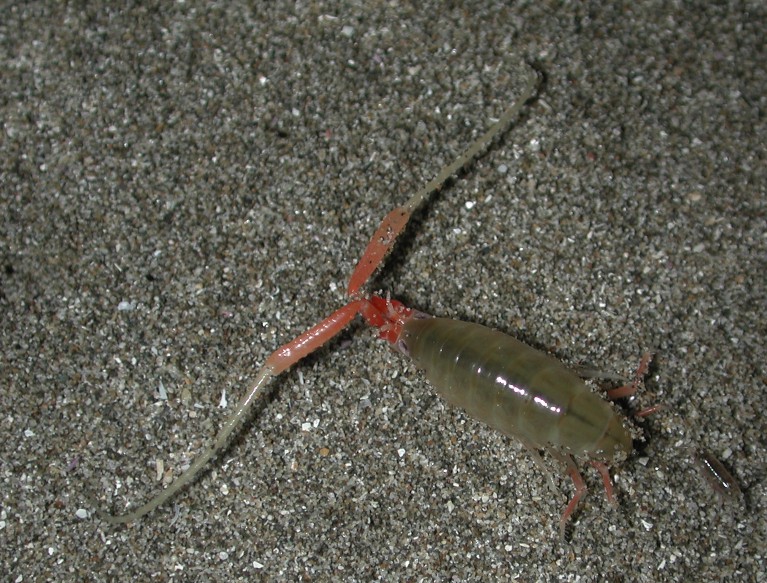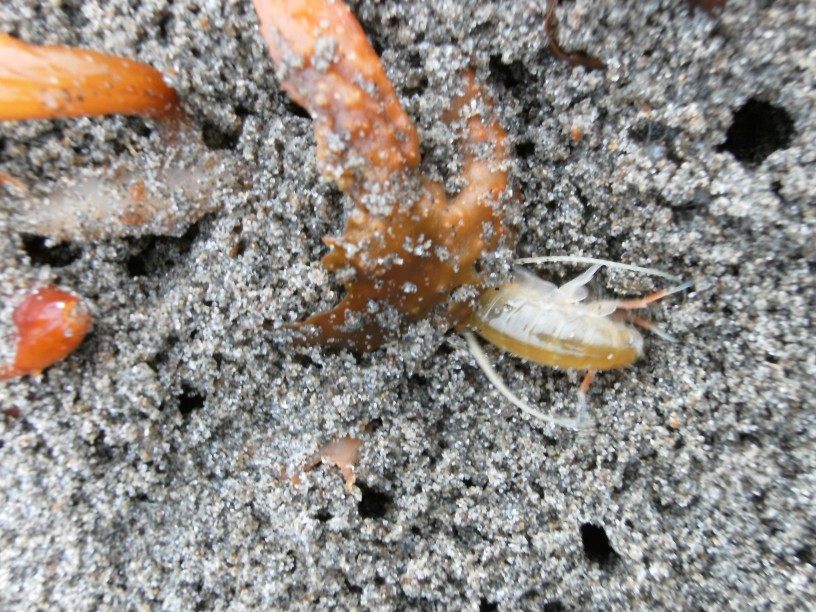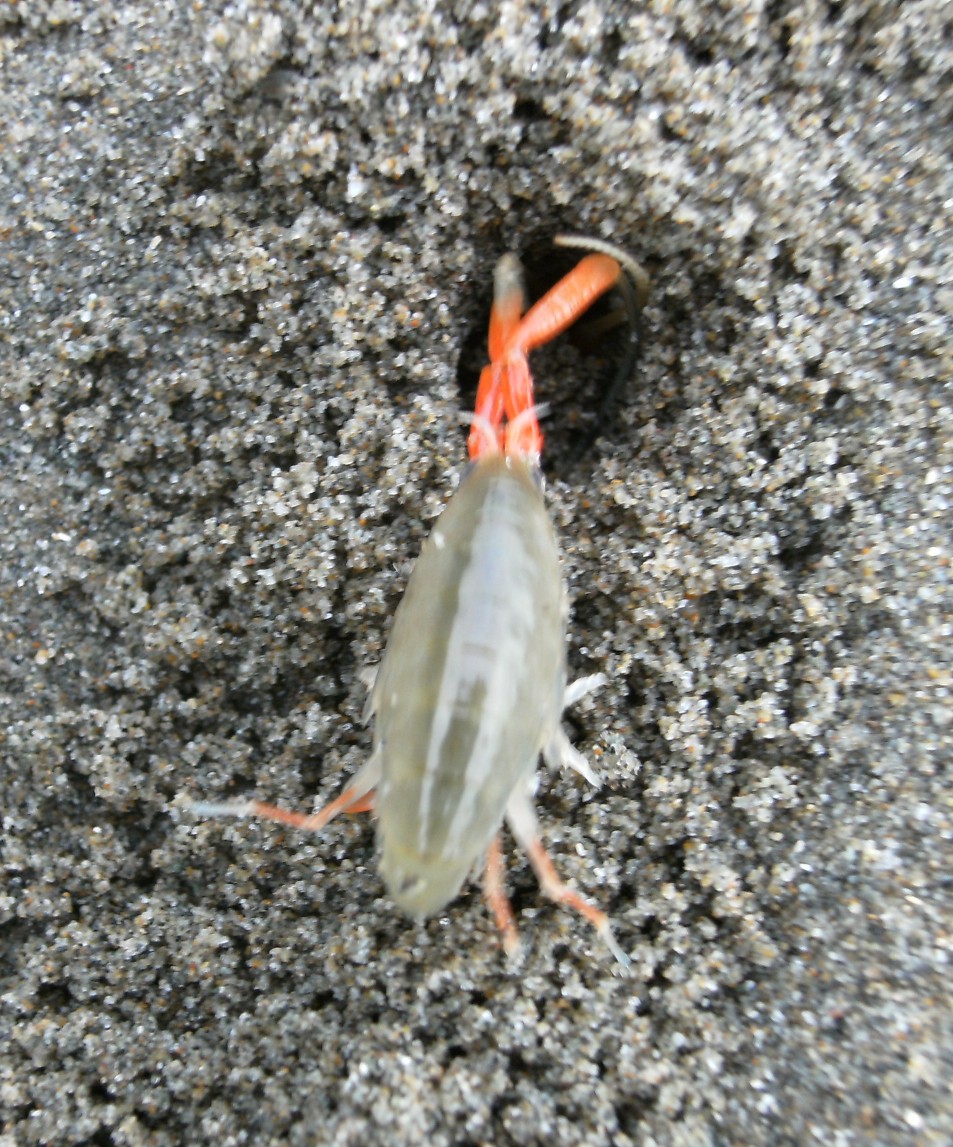Megalorchestia californiana Brandt, 1851Common name(s): California beach flea, California sand flea, California beach hopper, Long-horned beach hopper |
|
| Synonyms: Orchestoidea californiana |  |
|
Phylum Arthropoda
Subphylum Crustacea
Class Malacostraca
Subclass Eumalacostraca
Superorder Peracarida
Superfamily Talitroidea
Family Talitridae
|
|
| Megalorchestia californiana near decaying kelp on the high intertidal beach of Mukkaw Bay at dusk. Body length about 2 cm. Note how large this species is compared to the other amphipod seen behind it. | |
| (Photo by: Dave Cowles, July 2008) | |
How to Distinguish from Similar Species: The large size and distinctive orange or red color of the base of the second antennae make this species unique in our area.
Geographical Range: Vancouver Island, British Columbia to Laguna Beach, southern California
Depth Range:
Habitat: High intertidal zone of wide, fine sandy beaches on the open coast, usually near decaying seaweed. Especially common on beaches backed by dunes.
Biology/Natural History: This common species hides in burrows in the sand during the day, then comes out to feed on decaying seaweed at night. They often may move down near the water line to feed but return to burrows the higher beach afterward. They will drown if kept submerged in seawater. Males may fight over burrows near dawn in summer (less in winter), and have a plug of sand at the entrance. The burrows are up to 30 cm deepJuveniles have orange second antennae, while the antennae of adults are reddish. Juveniles also have a dark dorsal "butterfly" pattern and a dark mid-dorsal line.
Before molting, which normally occurs in the burrow, this species becomes opaque white dorsally, and this color spreads rapidly over the rest of the body. The animal twitches violently and splits the exoskeleton transversely between the first and second thoracic segments and longitudinally down both sides above the legs. The animal then lifts the dorsal plates and backs out. It can't jump normally for 24 hours after a molt.
The animals mate in their burrows from June to November in central CA. Females carry dark blue eggs which can be seen through their body wall while they are developing. After she releases 10-100 eggs and the male fertilizes them she carries the eggs in her marsupium (ventral side of her thorax) until they hatch.
Predators include many shorebirds, staphylinid beetles, and
racoons.
Adults often have parasitic mites such as Gammaridacarus
brevisternalis on the ventral surface.
| Return to: | |||
| Main Page | Alphabetic Index | Systematic Index | Glossary |
References:
Dichotomous Keys:Kozloff 1987, 1996
Smith and Carlton 1975 (As Orchestoidea californiana)
General References:
Brusca
and Brusca, 1978
Hinton,
1987 (as Orchestoidea
californiana)
Kozloff,
1993
Lamb
and Hanby, 2005
McConnaughey
and McConnaughey, 1990 (as Orchestoidea
californiana)
Morris
et al.,1980 (as Orchestoidea
californiana)
Ricketts
et al., 1985
Sept,
1999
Scientific Articles:
Web sites:
General Notes and Observations: Locations, abundances, unusual behaviors:

This individual is digging in under beach wrack (stranded algae) in the early morning hours. Several other amphipods have dug in nearby.
Photo from Shi Shi Beach by Dave Cowles, July 2008

This individual is heading down a typical burrow which it has just dug. Photo from Shi Shi beach by Dave Cowles, July 2008

Generally Megalorchestia californiana beachhoppers are out feeding at night and dig burrows to stay in during the day. I have seen many of their burrows underneath kelp high on the beach (see photos above). This view shows an unusual set of Megalorchestia californiana burrows at Shi Shi beach. The burrows are on a high brow of dry sand, just above a steep sand bank that drops to the lower beach. The photo is taken shortly after dawn. The night high tide came up and sculpted the sand bank but did not reach quite this far. When I passed by the area was covered with many Megalorchestia calforniana, some still walking around but most digging these characteristic, cone-like burrows. Each hole between the two pyramid-like mounds contains a beachhopper facing head-down and kicking sand up onto the mounds. The photo is looking directly away from the ocean so most of the beachhoppers were orienting themselves to the left and right on the beach whle they dug. Photo by Dave Cowles, late July 2008
Authors and Editors of Page:
Dave Cowles (2008): Created original page
CSS coding for page developed by Jonathan Cowles (2007)